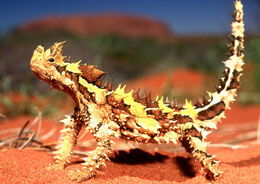
The thorny devil or thorny dragon (Moloch horridus) is an Australian Lizard, also known as the mountain devil, the thorny lizard, or the moloch. This is the sole species of genus Moloch. The thorny dragon grows up to 20 cm (7.9 in) in length, and it can live for up to 20 years. Most of these lizards are coloured in camouflaging shades of desert browns and tans. These colours change from pale colours during warm weather and to darker colours during cold weather. These animals are covered entirely with conical spines that are mostly uncalcified. The thorny devil also features a spiny "false head on the back of its neck, and the lizard presents this to potential predators by dipping its real head. The "false head" is made of soft tissue. The females are larger than the males. The thorny devil's scales are ridged, enabling the animal to collect water from any part of its body. That water is then conveyed to its mouth.
Description[]
An intimidating array of spikes covers the entire upper side of the body of the thorny devil. These thorny scales also help to defend it from predators. Camouflage and deception may also be used to evade predation. This lizard's unusual gait involves freezing and rocking as it moves about slowly in search of food, water, and mates.
Taxonomy and Naming[]
The names given to this lizard reflect its appearance: the two large horned scales on its head complete the illusion of a dragon. Although the name Moloch was formerly used for a deity of the ancient Near East, this name began to be used later in demonology to refer to the fallen angel and Prince of Hell. The thorny devil also has other nicknames people have given it such as the "devil lizard", "thorny devil", "horned lizard", and the "thorny toad". The thorny devil was first described in writing by the biologist John Edward Gray in 1841. While it is the only one contained in the genus Moloch, many taxonomists suspect another species might remain to be found in the wild. The thorny dragon is only distantly related to the similar (morphologically speaking) North American horned lizards of the genus Phrynosoma. This similarity is usually thought of as an example of convergent evolution.
Habitat[]
The thorny devil usually lives in the arid scrubland and desert that covers most of central Australia. For example, it inhabits the Spinifex (Triodia)sandplain and sandridge desert in the deep interior and the mallee belt. The habitation of the thorny dragon coincides more with the regions of sandy loam soils than with a particular climate in Western Australia.
Self Defence[]
The thorny devil is covered in hard, rather sharp spines that dissuade attacks by predators by making it difficult to swallow. It also has a false head on its back. When it feels threatened by other animals, it lowers its head between its front legs, and then presents its false head.
Diet[]
The thorny devil mainly subsists on ants it needs to eat at least 10.000 a day
especially Ochetellus flavipes and other species in the Iridomyrmex or Ochetellus genera. Thorny dragons often eat thousands of ants in one day. Thorny devils collect moisture in the dry desert by the condensation of dew on their bodies at night. This dew forms on its skin, and then it is channelled to its mouth in hygroscopic grooves between its spines. During rainfalls, capillary action allows the thorny dragon to suck in water from all over its body.
Breeding and Reproduction/Survival[]
The females lay clutch of three to ten eggs during the September–December season (spring-summer). They put these in a nesting burrow about 30 cm underground. The eggs hatch after about three to four months. Predators that consume thorny devils include wild birds and goannas.
Popular Reference[]
The popular appeal of the thorny devil is the basis of an anecdotal petty scam. American servicemen stationed in Southwest Australia decades ago (such as during World War II) were supposedly sold the thorny fruits of a species of weeds, the so-called "double gee" (Emex australis), but those were called "thorny devil eggs" as a part of the scam. Thorny dragons have been kept in captivity.